|
PETERSBURG National Battlefield |
 |
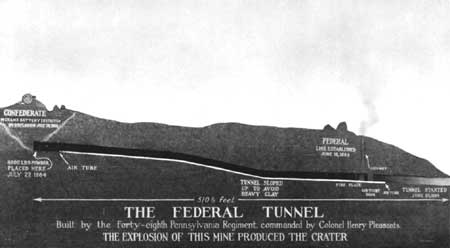
The Battle of the Crater, July 30, 1864
At several places east of the city the opposing lines were extremely close together. One of these locations was in front of Elliott's Salient, a Confederate strong point near Cemetery Hill and old Blandford Church. Here the Confederate position and the Union picket line were less than 400 feet apart. Because of the proximity of the Union line, Elliott's Salient was well fortified. Behind earthen embankments was a battery of four guns, and two veteran South Carolina infantry regiments were stationed on either side. Behind these were other defensive works; before them the ground sloped gently downward toward the Union advance line.
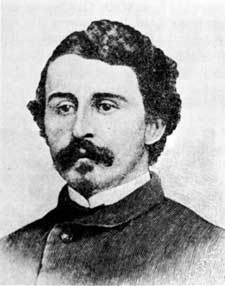 Lt. Col. Henry Pleasants, Commanding Officer of the 48th Pennsylvania Infantry Regiment which dug the Union tunnel under the Confederate line. From Battles and Leaders of the Civil War. |
This forward Union line was built on the crest of a ravine which had been crossed on June 18. Through this ravine, and between the sentry line and the main line, lay the roadbed of the Norfolk and Petersburg Railroad. The front in this sector was manned by Gen. Ambrose E. Burnside's IX Corps. Among the many units which composed this corps was the 48th Regiment, Pennsylvania Veteran Volunteer Infantry. A large proportion of this regiment had been coal miners, and it seemed to have occurred to one or more of them that Elliott's Salient would provide an excellent place to use their civilian occupation. Lt. Col. Henry Pleasants, the commanding officer of the 48th and a mining engineer by profession, overheard one of the enlisted men mutter, "We could blow that damned fort out of existence if we could run a mine shaft under it." From this and similar remarks came the germ of the idea for the Union mine. This is what the 48th Regiment proposed to do: dig a long gallery from the bottom of the ravine behind their picket line to a point beneath the Confederate battery at Elliott's Salient, blow up the position by means of powder placed in the end of the tunnel, and, finally, send a strong body of troops through the gap created in the enemy's line by the explosion. They saw as the reward for their effort the capitulation of Petersburg and, perhaps, the end of the war.
After obtaining the permission of Burnside and Grant, Pleasants and his men commenced digging their mine shaft on June 25. The lack of proper equipment made it necessary constantly to improvise tools and apparatus with which to excavate. Mining picks were created from straightened army picks. Cracker boxes were converted into hand barrows in which the dirt was removed from the end of the tunnel. A sawmill changed a bridge into timber necessary for shoring up the mine. Pleasants estimated both direction and depth of the tunnel by means of a theodolite (old-fashioned even in 1864) sent him from Washington. The outmoded instrument served its purpose well, however; the mine shaft hit exactly beneath the salient at which it was aimed.
One of the most remarkable features of the gallery was the method devised to supply the diggers at the end with fresh air. The longer the tunnel grew, the more serious became the problem of ventilation. It had been considered impossible to dig a tunnel for any considerable distance without spacing shafts at regular intervals in order to replace the polluted air with a fresh supply. This problem had been solved by the application of the simple physical principle that warm air tends to rise. Behind the Union picket line and to the right of the mine gallery, although connected with it, the miners dug a ventilating chimney. Between the chimney and the mine entrance they erected an airtight canvas door. Through that door and along the floor of the gallery there was laid a square wooden pipe. A fire was then built at the bottom of the ventilating shaft. As the fire warmed the air it went up the chimney. The draft thus created drew the bad air from the end of the tunnel where the men were digging. As this went out, fresh air was drawn in through the wooden pipe to replace it.
Work on the tunnel had been continuously pushed from the start on June 25. By July 17 the diggers were nearly 511 feet from the entrance and directly beneath the battery in Elliott's Salient. The Confederates had become suspicious by this time, for the faint sounds of digging could be heard issuing from the earth. Their apprehension took the form of countermines behind their own lines. Several of these were dug in an effort to locate the Union gallery. Two were very close, being sunk on either side of where the Pennsylvanians were at work. Although digging in the countermines continued throughout the month of July, Confederate fears seemed to quiet down during the same period. There were many reasons for this. One was the failure of their tunnels to strike any Union construction. Another major reason, undoubtedly, was a belief held by many that it was impossible to ventilate a shaft of any length over 400 feet without constructing air shafts along it.
The next step in the Union plan was to burrow out into lateral galleries at the end of the long shaft. Accordingly, on July 18 work was begun on these branches which extended to the right and left, paralleling the Confederate fortifications above. When completed, these added another 75 feet to the total length of the tunnel which now reached 586 feet into the earth. It was about 20 feet from the floor of the tunnel to the enemy works above. The average internal dimensions of the shaft were 5 feet high, with a base 4 1/2 feet in width tapering to 2 feet at the top.
Digging was finally completed on July 23. Four days later the task of charging the mine with black powder was accomplished. Three hundred and twenty kegs of powder weighing, on the average, 25 pounds each were arranged in the two lateral galleries in eight magazines. The total charge was 4 tons, or 8,000 pounds. The powder was sandbagged to direct the force of the explosion upward and two fuses were spliced together to form a 98-foot line.
Meanwhile, preparations for the attack which was to follow the explosion of the mine had been carried out. Burnside was convinced of the necessity for a large-scale attack by the entire IX Corps. His request was acceded to by Meade and Grant with but one important exception. It had been Burnside's hope that a fresh and numerically strong (about 4,300) Negro division should lead the charge after the explosion. Meade opposed this on the grounds that if the attack failed the Union commanders could be accused of wanting to get rid of the only Negro troops then with the Army of the Potomac. Burnside was not informed of this decision until the day before the battle, July 29, and he was forced to change his plans at the last moment. Three white divisions were to make the initial charge along with the colored troops. Burnside had the commanding generals of these three divisions draw straws to see which would lead. Gen. James F. Ledlie of the 1st Division won the draw.
Despite these eleventh-hour changes, a plan of battle had been evolved. During the night of July 29—30 the bulk of the IX Corps had assembled in the ravine behind the mine entrance. Troops from other Union corps were sent to act as reinforcements. A total of 110 guns and 54 mortars was alerted to begin their shelling of the Confederate line. A Union demonstration before Richmond had forced Lee to withdraw troops from Petersburg. Only about 18,000 soldiers were left to guard the city.
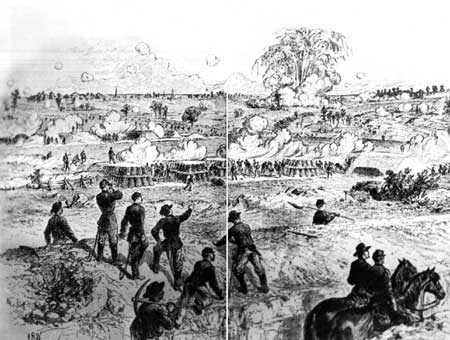
The explosion of the Union mine was recorded by
A.R. Waud, a contemporary artist.
From Battles and Leaders of
the Civil War.
At 3:15 a. m., July 30, Pleasants lit the fuse of the mine and mounted the parapet to see the results of his regiment's work. The explosion was expected at 3:30 a. m. Minutes passed slowly by, and the men huddled behind the lines grew more apprehensive. By 4:15 there could be no doubt but that something had gone wrong. Two volunteers from the 48th Regiment (Lt. Jacob Douty and Sgt. Harry Reese) crawled into the tunnel and found that the fuse had burned out at the splice. They relighted it and scrambled to safety. Finally, at about 4:45 a. m., the explosion took place. The earth trembled as men, equipment, and debris were hurled high into the air. At least 278 Confederate troops were killed or wounded in the tremendous blast, and 2 of the 4 guns in the battery were destroyed beyond repair. The measurements of the size of the crater torn by the powder vary considerably, but it seems to have been at least 170 feet long, 60 to 80 feet wide, and 30 feet deep.
The awesome spectacle of the mine explosion caused a delay in the Union charge following the explosion. Removal of obstructions between the lines caused further delay. Soon, however, an advance was made to the crater where many of the attacking force paused to seek shelter on its steep slopes or to look at the havoc caused by the mine. The hard-pressed Confederates tallied quickly and soon were pouring shells and bullets into their opponents. Union reinforcements poured into the breach; but, instead of going forward, they either joined their comrades in the crater or branched out to the immediate right and left along the lines. By 8:30 that morning a large part of the IX Corps had been poured into the captured enemy salient. Over 15,000 troops now filled and surrounded the crater.
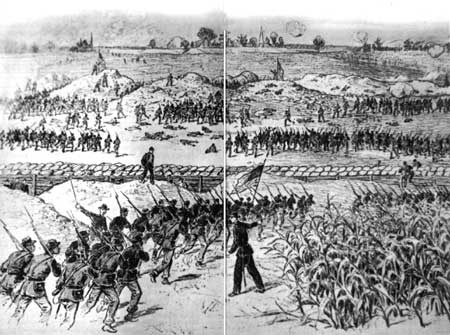
A contemporary sketch by Waud showing the Union
charge to the Crater.
From Battles and Leaders of
the Civil War.
By prompt action and determined effort the Confederates had stopped the attack. The attention of three batteries was soon directed on the Blue-clad men in the crater. Repeated volleys of artillery shot and shell raked the huddled groups of increasingly demoralized men. In addition, mortars were brought to within 50 yards of the crater and started to drop shells on the soldiers with deadly effect.
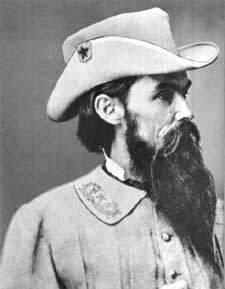 Maj. Gen. William Mahone, Confederate leader at the Battle of the Crater. Courtesy, National Archives. |
Successful as these devices were in halting the Union advance, Lee was aware that an infantry charge would be necessary to dislodge the enemy. By 6 a. m. an order had been sent to General Mahone to move two brigades of his division from the lines south of Petersburg to the defense of the threatened position. Then Lee joined Beauregard in observing the battle from the Gee house, 500 yards to the rear of the scene of strife.
In spite of the Confederate resistance, most of the Northern Negro division and other regiments had, by 8 a. m., advanced a short distance beyond their companions at the crater. Shortly after 8 o'clock Mahone's Confederate division began to arrive on the scene. The men fled into a ravine about 200 yards west of the crater and between it and Petersburg. No sooner had they entered this protected position than, perceiving the danger to their lines, they charged across the open field into the mass of enemy soldiers. Although outnumbered, they forced the Northerners to flee back to the comparative shelter of the crater. Then they swept on to regain a portion of the line north of the Union-held position. Again, at about 10:30 a. m., more of Mahone's troops charged, but were repulsed. Meanwhile, the lot of the Northern soldiers was rapidly becoming unbearable. The spectacle within the crater was appalling. Confederate artillery continued to beat upon them. The closely packed troops (dead, dying, and living mixed indiscriminately together) lacked shade from the blazing sun, food, water and, above all, competent leadership. Meade had ordered their withdrawal more than an hour before the second Confederate charge, but Burnside delayed the transmission of the order till after midday. Many men had chosen to run the gantlet of fire back to their own lines, but others remained clinging to the protective sides of the crater.
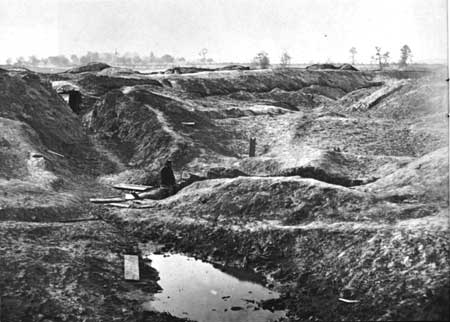
The Crater as it appeared in 1865. The Union
soldier seated at the end of the tunnel gives an idea of the size of the
Crater.
Courtesy, National Archives.
The last scene in the battle occurred shortly after 1 p. m. A final charge by Mahone's men was successful in gaining the slopes of the crater. Some of the Union men overcome with exhaustion and realizing the helplessness of their situation, surrendered; but others continued to fight. At one point where resistance centered, the Confederates put their hats on ramrods and lifted them over the rim of the crater. The caps were promptly torn to shreds by a volley. Before their foe could reload, Mahone's forces jumped into the crater where a desperate struggle with bayonets, rifle butts, and fists ensued.
Soon it was all over. The Union Army had suffered a loss of over 4,000 in killed, wounded, or captured as against about 1,500 for the Confederates. Again, as on June 15—18, a frontal assault had failed to take the Confederate citadel.

|

| History | Links to the Past | National Park Service | Search | Contact |
|
Last Modified: Mon, Dec 2 2002 10:00:00 am PDT |

